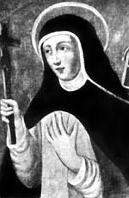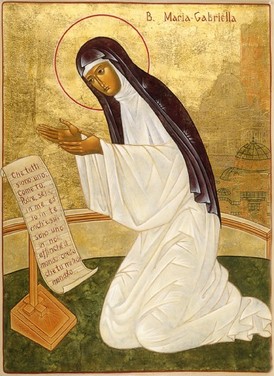Ecumenism: April 2010 Archives
 God of compassion, enkindle anew in our hearts the
love of your cross. By the life and prayers of Blessed Osanna, who suffered for
the unity of the Church, may we become sharers in both your passion and your
glory.
God of compassion, enkindle anew in our hearts the
love of your cross. By the life and prayers of Blessed Osanna, who suffered for
the unity of the Church, may we become sharers in both your passion and your
glory.

Lord God, eternal Shepherd, You inspired the blessed virgin, Maria Gabriella, generously to offer up her life for the sake of Christian unity. At her intercession, hasten, we pray, the coming of the day when, gathered around the table of Your word and of Your Bread from heaven, all who believe in Christ may sing Your praises with a single heart, a single voice.
Blessed Maria Gabriella, Sardinian by birth in 1914, she died a Trappistine nun in 1939 at Grottaferrata, having entered the monastery four years earlier. Taking up the invitation to work for spiritual ecumenism among Christians from Father Paul Couturier who stressed that all Christians must learn to pray together for unity in union with Jesus' own prayer for the same (Jn 17). Couturier advocated a spiritual unity founded on common prayer, charity, friendship, mutual forgiveness and humility which precedes doctrinal and hierarchical unity.
Father Couturier's work found a natural habitat in the monastic life which then became fruitful among the wider church (he called the latter the invisible monastery). As a side note, Couturier was greatly influenced by the his work in Lyon, France and by Dom Lambert Beaudoin and the monks of the Belgian abbey of Amay-sur-Meuse (now at Chevetogne).
Blessed Maria Gabriella's offering of self in 1938 for the spiritual ecumenism made known by Father Paul Couturier was a renewal of the same offering made on the day of her monastic profession of vows: not only to give her early life for Christian unity also to die for unity. This self-gift was closely connected to the notion that the profession of monastic vows is not isolated from the Church universal but deeply at the center of it because of the desire to totally give oneself to God. It is THE reversal of the sin of disunity that is based on ego and not on personal conversion.
Pope John Paul II beatified her on January 25, 1983. Blessed Maria Gabriella is buried at the Trappistine abbey of Our Lady of Saint Joseph at Vitorchiano (near to Viterbo) where her original community moved. She is known as the Apostle for Spiritual Ecumenism.
I recommend to you Sister Martha Driscoll, OCSO's A Silent
Herald of Unity: The Life of Blessed Maria Gabriella Sagheddu (Cistercian
Publications, 1990).
 As bishop, I am told, you are asked to sit on boards and be a voice for causes that you may not have too much interest in or knowledge of. While to the new Archbishop Dolan's portfolio as the archbishop of New York, he is the chairman of the board of the Catholic Near East Welfare Association (CNEWA) and is learning lots of new and beautiful things about the Church in other parts of the world. He made a recent trip to the Middle East with members of the governing board which opened his eyes to a new reality of what it is like to be an Eastern Christian. John Cardinal Foley, Grand Master of the Equestrian Order of Holy Sepulchre of Jerusalem accompanied the CNEWA board. The archbishop learned the beautiful horizons of the East and the limits thereof.
As bishop, I am told, you are asked to sit on boards and be a voice for causes that you may not have too much interest in or knowledge of. While to the new Archbishop Dolan's portfolio as the archbishop of New York, he is the chairman of the board of the Catholic Near East Welfare Association (CNEWA) and is learning lots of new and beautiful things about the Church in other parts of the world. He made a recent trip to the Middle East with members of the governing board which opened his eyes to a new reality of what it is like to be an Eastern Christian. John Cardinal Foley, Grand Master of the Equestrian Order of Holy Sepulchre of Jerusalem accompanied the CNEWA board. The archbishop learned the beautiful horizons of the East and the limits thereof.
